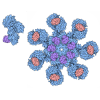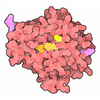+ Open data
Open data
- Basic information
Basic information
| Entry |  | |||||||||
|---|---|---|---|---|---|---|---|---|---|---|
| Title | Binary cluster of TNF-TNFR1 ectodomain complex | |||||||||
 Map data Map data | ||||||||||
 Sample Sample |
| |||||||||
 Keywords Keywords | TNF receptor / Receptor / Receptor cluster / IMMUNE SYSTEM | |||||||||
| Function / homology |  Function and homology information Function and homology informationpositive regulation of amide metabolic process / tumor necrosis factor receptor superfamily complex / pulmonary valve development / negative regulation of L-glutamate import across plasma membrane / negative regulation of bile acid secretion / response to Gram-negative bacterium / positive regulation of neutrophil activation / positive regulation of fractalkine production / negative regulation of branching involved in lung morphogenesis / positive regulation of interleukin-33 production ...positive regulation of amide metabolic process / tumor necrosis factor receptor superfamily complex / pulmonary valve development / negative regulation of L-glutamate import across plasma membrane / negative regulation of bile acid secretion / response to Gram-negative bacterium / positive regulation of neutrophil activation / positive regulation of fractalkine production / negative regulation of branching involved in lung morphogenesis / positive regulation of interleukin-33 production / positive regulation of lipid metabolic process / positive regulation of blood microparticle formation / aortic valve development / positive regulation of chronic inflammatory response to antigenic stimulus / tumor necrosis factor receptor activity / negative regulation of extracellular matrix constituent secretion / response to 3,3',5-triiodo-L-thyronine / positive regulation of protein transport / positive regulation of leukocyte adhesion to arterial endothelial cell / positive regulation of vitamin D biosynthetic process / positive regulation of apoptotic process involved in morphogenesis / positive regulation of translational initiation by iron / regulation of membrane lipid metabolic process / regulation of endothelial cell apoptotic process / chronic inflammatory response to antigenic stimulus / response to macrophage colony-stimulating factor / regulation of branching involved in salivary gland morphogenesis / negative regulation of protein-containing complex disassembly / positive regulation of humoral immune response mediated by circulating immunoglobulin / positive regulation of hair follicle development / negative regulation of myelination / response to gold nanoparticle / TNFs bind their physiological receptors / tumor necrosis factor binding / negative regulation of vascular wound healing / negative regulation of cytokine production involved in immune response / negative regulation of amyloid-beta clearance / positive regulation of interleukin-18 production / inflammatory response to wounding / negative regulation of cardiac muscle hypertrophy / death receptor agonist activity / positive regulation of action potential / TNF signaling / epithelial cell proliferation involved in salivary gland morphogenesis / toll-like receptor 3 signaling pathway / embryonic digestive tract development / negative regulation of D-glucose import / leukocyte migration involved in inflammatory response / vascular endothelial growth factor production / positive regulation of fever generation / response to fructose / positive regulation of neuroinflammatory response / positive regulation of synoviocyte proliferation / positive regulation of calcineurin-NFAT signaling cascade / necroptotic signaling pathway / positive regulation of mononuclear cell migration / leukocyte tethering or rolling / positive regulation of hepatocyte proliferation / negative regulation of myoblast differentiation / positive regulation of protein-containing complex disassembly / regulation of establishment of endothelial barrier / endothelial cell apoptotic process / negative regulation of oxidative phosphorylation / regulation of tumor necrosis factor-mediated signaling pathway / cellular response to toxic substance / positive regulation of protein localization to cell surface / macrophage activation involved in immune response / negative regulation of systemic arterial blood pressure / positive regulation of osteoclast differentiation / tumor necrosis factor receptor binding / positive regulation of heterotypic cell-cell adhesion / positive regulation of macrophage derived foam cell differentiation / positive regulation of cytokine production involved in inflammatory response / regulation of immunoglobulin production / TNFR1-mediated ceramide production / negative regulation of mitotic cell cycle / positive regulation of programmed cell death / positive regulation of podosome assembly / positive regulation of membrane protein ectodomain proteolysis / positive regulation of chemokine (C-X-C motif) ligand 2 production / regulation of fat cell differentiation / regulation of canonical NF-kappaB signal transduction / response to L-glutamate / positive regulation of extrinsic apoptotic signaling pathway / positive regulation of leukocyte adhesion to vascular endothelial cell / TNFR1-induced proapoptotic signaling / negative regulation of bicellular tight junction assembly / regulation of metabolic process / regulation of reactive oxygen species metabolic process / positive regulation of DNA biosynthetic process / prostaglandin metabolic process / negative regulation of heart rate / positive regulation of amyloid-beta formation / negative regulation of viral genome replication / response to isolation stress / negative regulation of fat cell differentiation / regulation of synapse organization / negative regulation of endothelial cell proliferation / positive regulation of JUN kinase activity / positive regulation of MAP kinase activity Similarity search - Function | |||||||||
| Biological species |  Homo sapiens (human) Homo sapiens (human) | |||||||||
| Method | single particle reconstruction / cryo EM / Resolution: 2.56 Å | |||||||||
 Authors Authors | Lim CS / Lee JO | |||||||||
| Funding support |  Korea, Republic Of, 1 items Korea, Republic Of, 1 items
| |||||||||
 Citation Citation |  Journal: Nat Commun / Year: 2025 Journal: Nat Commun / Year: 2025Title: Highly ordered clustering of TNFα and BAFF ligand-receptor-intracellular adaptor complexes on a lipid membrane. Authors: Chan Seok Lim / Jisun Lee / Ji Won Kim / Jie-Oh Lee /  Abstract: The TNF family plays a critical role in immune regulation. Here, we present high-resolution structures of clusters formed by two TNF receptor family proteins, TNFR1 and BAFFR. Using a lipid monolayer ...The TNF family plays a critical role in immune regulation. Here, we present high-resolution structures of clusters formed by two TNF receptor family proteins, TNFR1 and BAFFR. Using a lipid monolayer method to mimic their membrane-bound state, we observe that the TNFα-TNFR1 complex forms highly ordered clusters of trimers on the lipid membrane. A non-competitive TNFR1 antagonist that inhibits receptor activation disrupted these clusters without blocking ligand binding or receptor trimerization. Furthermore, we find that the BAFF-BAFFR, BAFF-TACI, and BAFF-BCMA receptor-ligand complexes predominantly form pentagonal clusters of trimers on the lipid membrane. Notably, the binding of the intracellular adaptor TRAF3 to the BAFF-BAFFR complex induces a structural transition from a pentagonal to a flat hexagonal cluster. Mutations in BAFF that impair BAFFR activation prevented cluster formation. Our findings demonstrate that ligand binding induces the formation of highly ordered clusters of TNFR1 and BAFFR receptors on the lipid membrane, which is essential for their activation. | |||||||||
| History |
|
- Structure visualization
Structure visualization
| Supplemental images |
|---|
- Downloads & links
Downloads & links
-EMDB archive
| Map data |  emd_60484.map.gz emd_60484.map.gz | 156.1 MB |  EMDB map data format EMDB map data format | |
|---|---|---|---|---|
| Header (meta data) |  emd-60484-v30.xml emd-60484-v30.xml emd-60484.xml emd-60484.xml | 19.1 KB 19.1 KB | Display Display |  EMDB header EMDB header |
| FSC (resolution estimation) |  emd_60484_fsc.xml emd_60484_fsc.xml | 11.9 KB | Display |  FSC data file FSC data file |
| Images |  emd_60484.png emd_60484.png | 67.5 KB | ||
| Filedesc metadata |  emd-60484.cif.gz emd-60484.cif.gz | 6.3 KB | ||
| Others |  emd_60484_half_map_1.map.gz emd_60484_half_map_1.map.gz emd_60484_half_map_2.map.gz emd_60484_half_map_2.map.gz | 164.9 MB 164.9 MB | ||
| Archive directory |  http://ftp.pdbj.org/pub/emdb/structures/EMD-60484 http://ftp.pdbj.org/pub/emdb/structures/EMD-60484 ftp://ftp.pdbj.org/pub/emdb/structures/EMD-60484 ftp://ftp.pdbj.org/pub/emdb/structures/EMD-60484 | HTTPS FTP |
-Validation report
| Summary document |  emd_60484_validation.pdf.gz emd_60484_validation.pdf.gz | 636.6 KB | Display |  EMDB validaton report EMDB validaton report |
|---|---|---|---|---|
| Full document |  emd_60484_full_validation.pdf.gz emd_60484_full_validation.pdf.gz | 636.2 KB | Display | |
| Data in XML |  emd_60484_validation.xml.gz emd_60484_validation.xml.gz | 20.5 KB | Display | |
| Data in CIF |  emd_60484_validation.cif.gz emd_60484_validation.cif.gz | 26.8 KB | Display | |
| Arichive directory |  https://ftp.pdbj.org/pub/emdb/validation_reports/EMD-60484 https://ftp.pdbj.org/pub/emdb/validation_reports/EMD-60484 ftp://ftp.pdbj.org/pub/emdb/validation_reports/EMD-60484 ftp://ftp.pdbj.org/pub/emdb/validation_reports/EMD-60484 | HTTPS FTP |
-Related structure data
| Related structure data |  8zuiMC  8zujC  8zukC M: atomic model generated by this map C: citing same article ( |
|---|---|
| Similar structure data | Similarity search - Function & homology  F&H Search F&H Search |
- Links
Links
| EMDB pages |  EMDB (EBI/PDBe) / EMDB (EBI/PDBe) /  EMDataResource EMDataResource |
|---|---|
| Related items in Molecule of the Month |
- Map
Map
| File |  Download / File: emd_60484.map.gz / Format: CCP4 / Size: 178 MB / Type: IMAGE STORED AS FLOATING POINT NUMBER (4 BYTES) Download / File: emd_60484.map.gz / Format: CCP4 / Size: 178 MB / Type: IMAGE STORED AS FLOATING POINT NUMBER (4 BYTES) | ||||||||||||||||||||||||||||||||||||
|---|---|---|---|---|---|---|---|---|---|---|---|---|---|---|---|---|---|---|---|---|---|---|---|---|---|---|---|---|---|---|---|---|---|---|---|---|---|
| Projections & slices | Image control
Images are generated by Spider. | ||||||||||||||||||||||||||||||||||||
| Voxel size | X=Y=Z: 0.82 Å | ||||||||||||||||||||||||||||||||||||
| Density |
| ||||||||||||||||||||||||||||||||||||
| Symmetry | Space group: 1 | ||||||||||||||||||||||||||||||||||||
| Details | EMDB XML:
|
-Supplemental data
-Half map: #1
| File | emd_60484_half_map_1.map | ||||||||||||
|---|---|---|---|---|---|---|---|---|---|---|---|---|---|
| Projections & Slices |
| ||||||||||||
| Density Histograms |
-Half map: #2
| File | emd_60484_half_map_2.map | ||||||||||||
|---|---|---|---|---|---|---|---|---|---|---|---|---|---|
| Projections & Slices |
| ||||||||||||
| Density Histograms |
- Sample components
Sample components
-Entire : Binary cluster of TNF-TNFR1 ectodomain 3:3 complex
| Entire | Name: Binary cluster of TNF-TNFR1 ectodomain 3:3 complex |
|---|---|
| Components |
|
-Supramolecule #1: Binary cluster of TNF-TNFR1 ectodomain 3:3 complex
| Supramolecule | Name: Binary cluster of TNF-TNFR1 ectodomain 3:3 complex / type: complex / ID: 1 / Parent: 0 / Macromolecule list: all |
|---|---|
| Source (natural) | Organism:  Homo sapiens (human) Homo sapiens (human) |
-Macromolecule #1: Tumor necrosis factor
| Macromolecule | Name: Tumor necrosis factor / type: protein_or_peptide / ID: 1 / Details: TNF ligand / Number of copies: 6 / Enantiomer: LEVO |
|---|---|
| Source (natural) | Organism:  Homo sapiens (human) Homo sapiens (human) |
| Molecular weight | Theoretical: 18.855344 KDa |
| Recombinant expression | Organism:  Trichoplusia ni (cabbage looper) Trichoplusia ni (cabbage looper) |
| Sequence | String: ADPVRSSSRT PSDKPVAHVV ANPQAEGQLQ WLNRRANALL ANGVELRDNQ LVVPSEGLYL IYSQVLFKGQ GCPSTHVLLT HTISRIAVS YQTKVNLLSA IKSPCQRETP EGAEAKPWYE PIYLGGVFQL EKGDRLSAEI NRPDYLDFAE SGQVYFGIIA L EFRSGRLV PR UniProtKB: Tumor necrosis factor |
-Macromolecule #2: Tumor necrosis factor receptor superfamily member 1A, membrane form
| Macromolecule | Name: Tumor necrosis factor receptor superfamily member 1A, membrane form type: protein_or_peptide / ID: 2 / Number of copies: 6 / Enantiomer: LEVO |
|---|---|
| Source (natural) | Organism:  Homo sapiens (human) Homo sapiens (human) |
| Molecular weight | Theoretical: 22.190912 KDa |
| Recombinant expression | Organism:  Trichoplusia ni (cabbage looper) Trichoplusia ni (cabbage looper) |
| Sequence | String: ADPLVPHLGD REKRDSVCPQ GKYIHPQNNS ICCTKCHKGT YLYNDCPGPG QDTDCRECES GSFTASENHL RHCLSCSKCR KEMGQVEIS SCTVDRDTVC GCRKNQYRHY WSENLFQCFN CSLCLNGTVH LSCQEKQNTV CTCHAGFFLR ENECVSCSNC K KSLECTKL ...String: ADPLVPHLGD REKRDSVCPQ GKYIHPQNNS ICCTKCHKGT YLYNDCPGPG QDTDCRECES GSFTASENHL RHCLSCSKCR KEMGQVEIS SCTVDRDTVC GCRKNQYRHY WSENLFQCFN CSLCLNGTVH LSCQEKQNTV CTCHAGFFLR ENECVSCSNC K KSLECTKL CLPQIENVKG TEDSGTTGGG GSHHHHHHHH UniProtKB: Tumor necrosis factor receptor superfamily member 1A |
-Experimental details
-Structure determination
| Method | cryo EM |
|---|---|
 Processing Processing | single particle reconstruction |
| Aggregation state | particle |
- Sample preparation
Sample preparation
| Concentration | 0.1 mg/mL | |||||||||
|---|---|---|---|---|---|---|---|---|---|---|
| Buffer | pH: 7.8 Component:
| |||||||||
| Grid | Model: Quantifoil R1.2/1.3 / Material: GOLD / Mesh: 300 / Support film - Material: CARBON / Support film - topology: HOLEY | |||||||||
| Vitrification | Cryogen name: ETHANE / Chamber humidity: 100 % / Chamber temperature: 293 K / Instrument: FEI VITROBOT MARK IV |
- Electron microscopy
Electron microscopy
| Microscope | TFS KRIOS |
|---|---|
| Image recording | Film or detector model: GATAN K3 BIOQUANTUM (6k x 4k) / Average electron dose: 50.0 e/Å2 |
| Electron beam | Acceleration voltage: 300 kV / Electron source:  FIELD EMISSION GUN FIELD EMISSION GUN |
| Electron optics | Illumination mode: FLOOD BEAM / Imaging mode: BRIGHT FIELD / Nominal defocus max: 2.0 µm / Nominal defocus min: 0.8 µm |
| Experimental equipment |  Model: Titan Krios / Image courtesy: FEI Company |
 Movie
Movie Controller
Controller



























 Z (Sec.)
Z (Sec.) Y (Row.)
Y (Row.) X (Col.)
X (Col.)







































